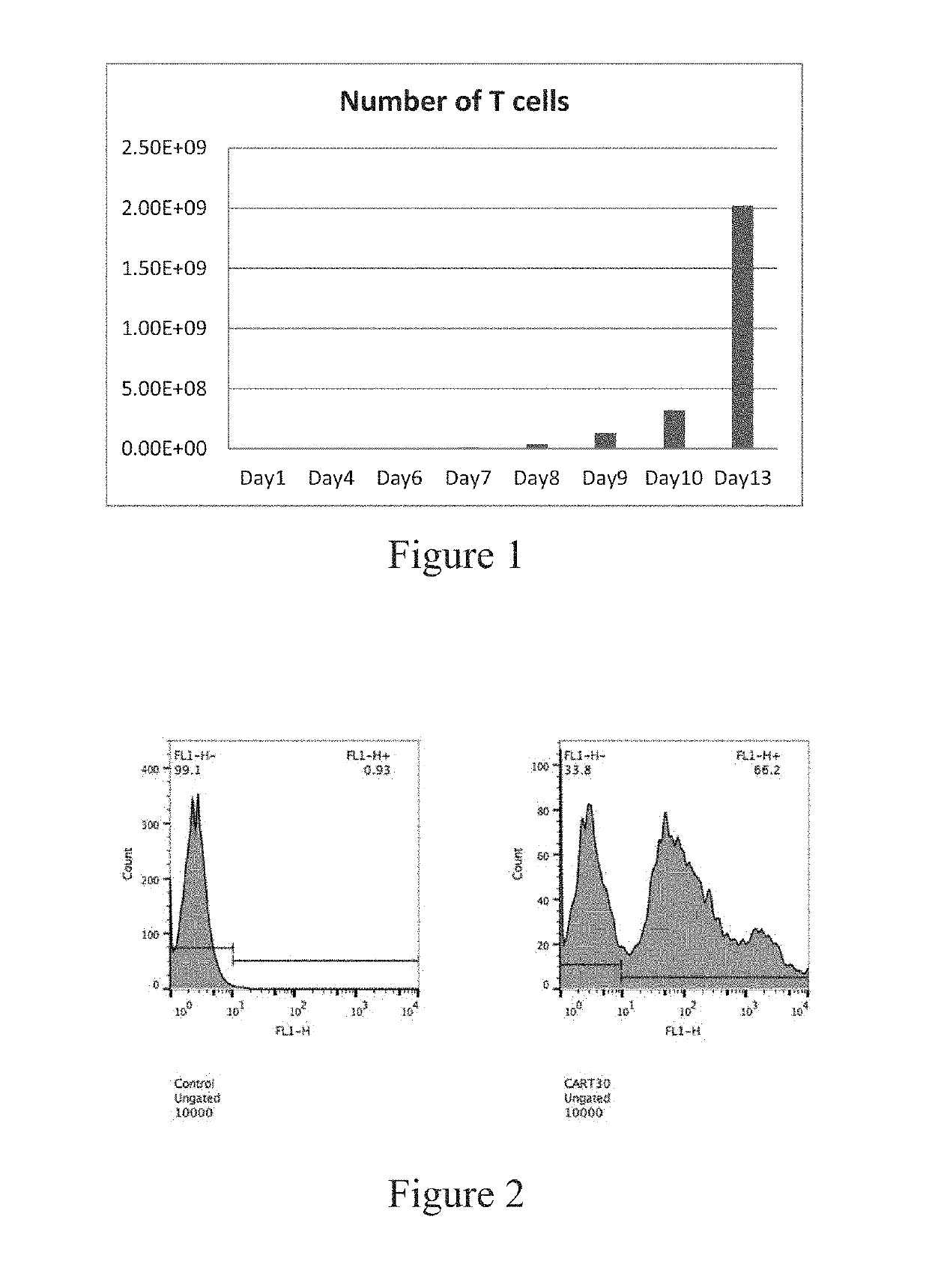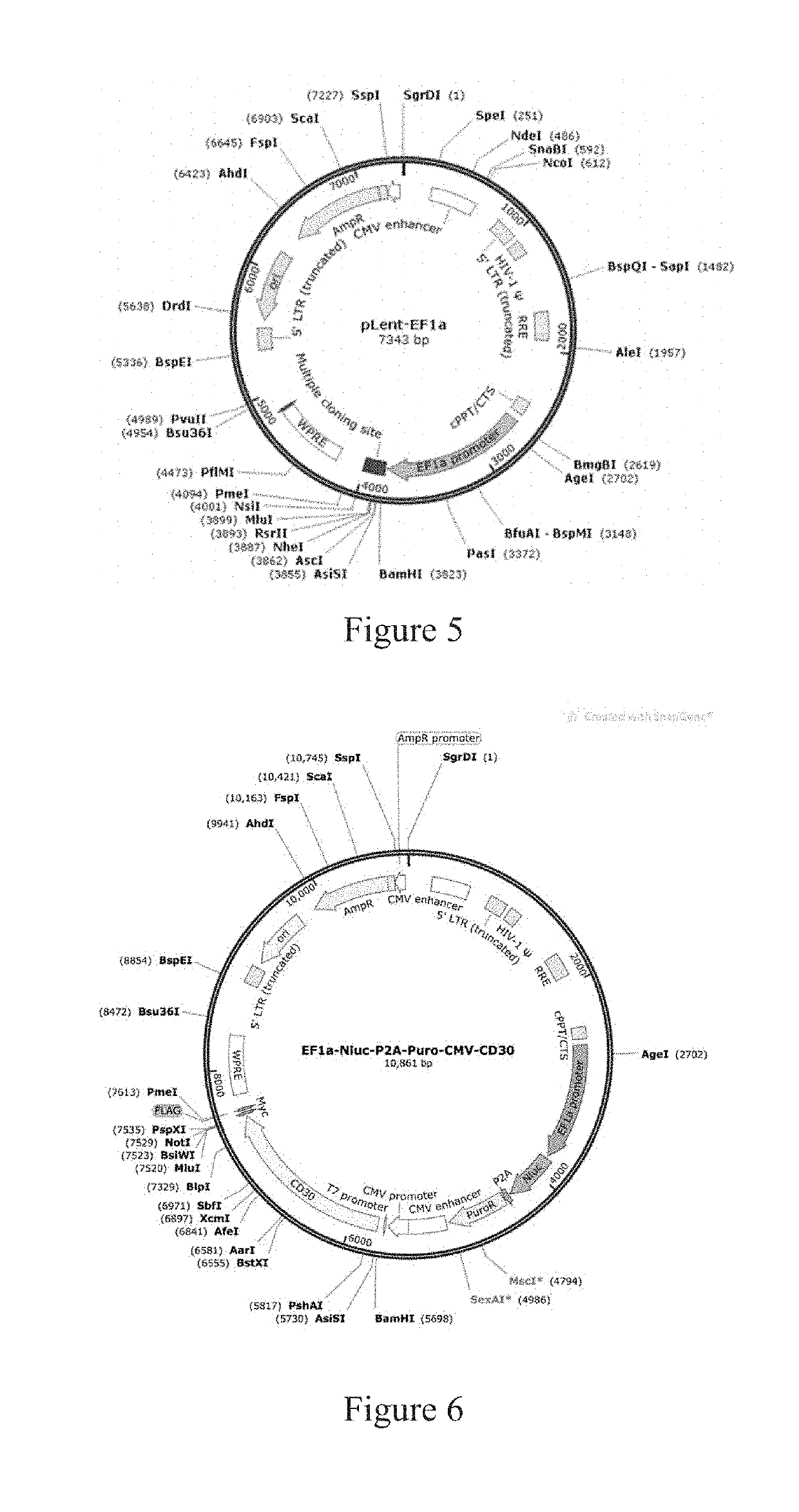Recombinant chimeric antigen receptor gene and use thereof
a chimeric antigen receptor and recombinant technology, applied in the field of tumor treatment, can solve the problem that the signal complex cannot fully replicate the multi-stranded tcr signal complex, and achieve the effect of promoting car-t to specific kill, improving proliferation capability, and high specificity for cd30-positive tumors
- Summary
- Abstract
- Description
- Claims
- Application Information
AI Technical Summary
Benefits of technology
Problems solved by technology
Method used
Image
Examples
examples 1
[0101]Construction of the Plasmid CART-30 scFv
[0102]The method for obtaining the plasmid CART-30 scFv: designing the coding nucleotide sequences of the scFvs of the three CD30 antibodies (including the CD8a signal peptide coding sequence (SEQ ID NO: 26) and the scFv fragment coding sequences set forth in SEQ ID NOs: 23, 24 and 25, respectively) and ligating to the sequences set forth in SEQ ID NOs: 11, 12 and 13 to form 3 CAR genes:
[0103]CAR1: consisting of SEQ ID NOs: 26, 23, 11, 12 and 13;
[0104]CAR2: consisting of SEQ ID NOs: 26, 24, 11, 12 and 13; and
[0105]CAR3: consisting of SEQ ID NOs: 26, 25, 11, 12 and 13 (SEQ ID NO:21).
[0106]The complete sequences of the recombinant CAR1-3 genes were synthesized (GenScript), and was ligated into the lentiviral plasmid vector pLent-EF1a (Vigene Biosciences) by digestion with AsisI / NsiI (NEB Corporation). The plasmid maps of the constructed CART-30 scFv plasmid and pLent-EF1a are shown in FIG. 4 and FIG. 5.
example 2
[0107]The CART-30 scFv plasmids constructed in Example 1 were subjected to lentivirus packaging and purification, and the recombinant CAR genes were expressed on T lymphocytes by lentiviral vector technology (see Tumaini B, Lee D W, Lin T, Castiello L, et al. Simplified process for the production of anti-CD19-CAR engineered T cells. Cytotherapy. 2013; 15(11): 1406-1415), and the positive infection efficiency was detected by flow cytometry. The results are shown in FIGS. 2 and 3. The transfection efficiency of T lymphocytes with the lentivirus is approximately 60%.
example 3
In Vitro Detection of Killing Efficiency
[0108]1. Construction of CAR-T cytotoxicity indicator vector: Constructed according to the method described in Chinese Patent Application No. 201610537806.3. Briefly:
(1) Synthesizing a nucleotide sequence encoding Nanoluc® Luciferase, P2A and CD30 (SEQ ID NO: 30), and introducing AsisI and MluI restriction sites upstream and downstream, respectively;
(2) digesting the Plent-EF1α-Puro-CMV vector and the Nanoluc® Luciferase-P2A-CD30 sequence obtained in step (1) with Asis I and MluI at 37° C., and recovering the digested Nanoluc® Luciferase-P2A-CD30 sequence and Plent-EF1α-Puro-CMV vector using a DNA gel recovery kit;
(3) ligating the digested Nanoluc® Luciferase-P2A-CD30 sequence and Plent-EF1α-Puro-CMV vector at 22° C. for 2 hours, and transforming the ligation product into E. coli DH5α competent cells to obtain the cytotoxicity indicator vector pLent-EF1a-Nluc-P2A-Puro-CMV-CD30.
[0109]2. In Vitro Toxicity Testing
[0110]The obtained pLent-EF1a-Nlu...
PUM
| Property | Measurement | Unit |
|---|---|---|
| Time | aaaaa | aaaaa |
| Time | aaaaa | aaaaa |
| Fraction | aaaaa | aaaaa |
Abstract
Description
Claims
Application Information
 Login to View More
Login to View More - R&D
- Intellectual Property
- Life Sciences
- Materials
- Tech Scout
- Unparalleled Data Quality
- Higher Quality Content
- 60% Fewer Hallucinations
Browse by: Latest US Patents, China's latest patents, Technical Efficacy Thesaurus, Application Domain, Technology Topic, Popular Technical Reports.
© 2025 PatSnap. All rights reserved.Legal|Privacy policy|Modern Slavery Act Transparency Statement|Sitemap|About US| Contact US: help@patsnap.com



